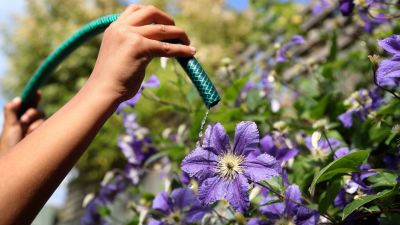When Thames Water hosepipe ban starts and what rules will be in place

Thames Water has confirmed that a hosepipe ban for its 15 million customers will start next week.
From 24 August, customers should not use hosepipes for cleaning cars, watering gardens or allotments, filling paddling pools and swimming pools, or for cleaning windows.
While the Temporary Use Ban does not cover businesses, Thames Water is asking businesses across its area to be mindful of the drought and to use water wisely, such as not washing commercial vehicles and turning off water features on their properties.
Thames Water supplies London and the Thames Valley, as well as area of Wiltshire and Gloucestershire.
The driest July since 1885, the hottest temperatures on record, and the River Thames reaching its lowest level since 2005 have led to a drop in reservoir levels across the region.
The recent heatwave and extreme temperatures have resulted in the highest demand for more than 25 years with the company supplying 2.9 billion litres of water a day to customers across the region.
In some areas during the particularly hot weather, demand for water rose by 50% compared to the norm for the time of year.
Sarah Bentley, Thames Water CEO said: "Implementing a Temporary Use Ban for our customers has been a very difficult decision to make and one which we have not taken lightly.
"After months of below average rainfall and the recent extreme temperatures in July and August, water resources in our region are depleted.
"Despite investing in the largest leakage reduction programme in the UK, customer demand is at unprecedented levels and we now have to move into the next phase of our drought plan to conserve water, mitigate further risk and futureproof supplies.
"I'd like to thank all of our customers for the efforts they have already made to conserve water as a result of the media campaign we have been running since May.
"Reducing demand means reducing the amount of water we have to take from the environment at a time when it is under pressure.
"I would also like to apologise to our customers who have been affected by recent incidents, our dedicated colleagues are working around the clock to manage this challenging situation."
The announcement comes after people living in parts of Surrey and Sussex spent days without water due to a fault at a nearby treatment plant.
Around 8,000 homes in and around Cranleigh were affected. The fault, at Netley Mill Water Treatment Works, has since been fixed.
On Sunday (14 August), Thames Water said supplies had been restored to the majority of homes left without water. The firm has apologised for it taking longer than expected.
Thames Water says it is fixing more than 1,100 leaks on its 20,000 mile network every week and has met its leakage reduction targets for the past three years.
In addition to the large leakage reductions, it is estimated a Temporary Use Ban will help save up to a further 10% of water.
Groundwater levels are currently below normal throughout the region and declining towards levels that would be only be expected once a decade.
Reservoir storage levels in London and Farmoor, in Oxfordshire, have reduced significantly and are now at levels not seen for around 30 years.
Alongside a significant leakage reduction programme, Thames Water is drawing 120 million litres of groundwater from its North London Aquifer Recharge System (NLARS) to top-up the water stored in our reservoirs.
Thames Water estimates 150 litres of water are used per person every day, reducing daily demand to closer to 100 litres is crucial alongside fixing leaks.
In the longer term, as part of its water resources management plan, Thames Water says it is working with its regulators and the water industry to look at options to secure future water supplies.
This includes options for water transfers from areas around the country from areas where it is abundant to areas where it is scarce as well as further storage options so that water can be collected at times of plenty for use during drier times of year when demand is higher.